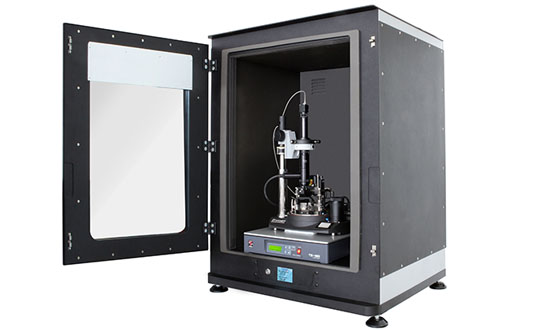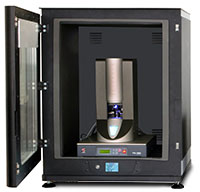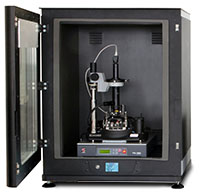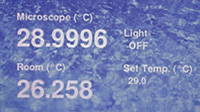Outstanding Performance
High performance of the thermal cabinet has been tested in respect to its damping of the external acoustic noise, vibrational protection, and temperature stability. A graph that shows the difference between the inside acoustic noise with the front door both opened and closed, is presented in Figure 1.
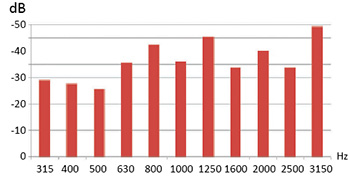
Figure 1. Demonstration of acoustic protection with sound pressure loss in a closed thermal cabinet.
The graph demonstrates a substantial reduction of the sensor signal in the broad frequency range after closing the cabinet door. In other tests the AFM deflection signal of a probe with a spring constant of 12 N/m, which stayed in the contact with a sample, was measured to detect the external mechanical vibrations.
The latter were caused either by human traffic near the cabinet or by operating a vacuum pump, which was placed at the same table as the cabinet. The deflection measurements were performed for the microscope placed on the bungee cords’ support and on the active vibration protection tablet TS-150 in “off” and “on” conditions. The comparative deflection signal values, which were obtained in these experiments, are shown in Table 1.
Table 1. The AFM Probe Deflection at Different Noise Conditions and Various Microscope’s Supports

* Numbers in the table are RMS in nm
The most important test is controlling for temperature stability and thermal drift of the microscope inside the cabinet. Typically, the set-point temperature at the sample stage of the microscope is chosen 3-4 degrees °C above the room temperature. After switching on the cabinet heaters, several hours are needed to bring the microscope to the set-point temperature. In an air-conditioned room, the temperature may oscillate as much as 3 °C.
Such fluctuations are on the extreme side, but they can be successfully dampened by the cabinet features so that the variations of the microscope temperature are only in the 8 millidegree °C range.
This situation is illustrated by the graphs in Figure 2.
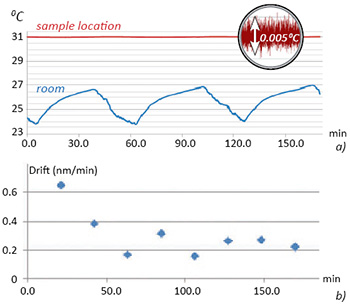
Figure 2. a) Temporal variations of room and sample location temperatures. b) A reduction of thermal drift after the cabinet door was shut
The temperature variations proceed rather slowly with time constant around 50 minutes. Even more important, such temperature conditions lead to very small thermal drift (approx. 0.2 nm/min) in AFM images, which were obtained in the continuous scanning of the areas from 4 nm to 300 nm on side, as proven by the data below. The conditions are further improved when the room temperature variations are smaller (down to 1 degree °C) and the temperature stability of 5 millidegree °C has been achieved in such cases. When the cabinet door is opened for a several minutes in order to change a probe or a sample, the microscope temperature drops. After the door is closed, the microscope temperature recovers to the set-point level within tens of minutes. This process proceeds gradually, and it has a minimal influence on thermal drift. Several AFM images were chosen to illustrate the microscope performance at the low thermal drift conditions. They include the atomic-scale images of mica, normal alkane C22H46 on graphite, WTe2, HOPG (Figure 3) and a series of the dC/dZ images of semifluorinated alkane on HOPG (Figure 4).
These dC/dZ images were recorded with the scanning rate in the 1-2 Hz range that allows precise recording of the surface corrugations reflecting atomic and molecular arrangement in these samples. The practically immobile positions of donut-shaped and ribbon-like self-assemblies of semifluorinated alkane (Figure 4) underline low thermal drift of the microscope.
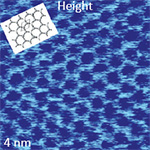
Mica
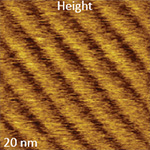
Normal alkanes C22H46 on HOPG
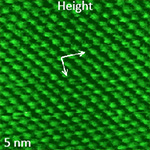
WTe2
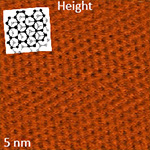
HOPG
Figures 3. Height images (512x512) with atomic and molecular scale resolution of several compounds, which were recorded with scanning rates of 1.5 - 2 Hz in the contact and amplitude modulation mode. The studies were made with NEXT microscope inside the cabinet, and the bungee cords’ damping was used
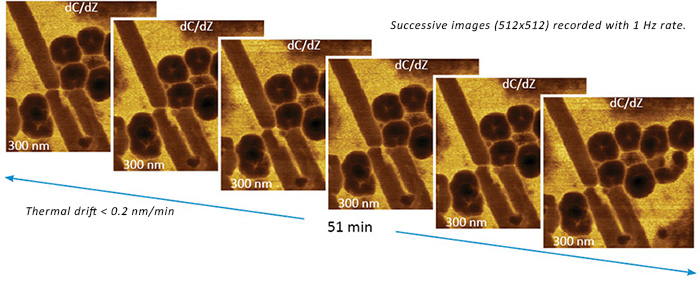
Figures 4. Demonstration of low thermal drift on the sample of self-assemblies of semifluorinated alkane on HOPG







